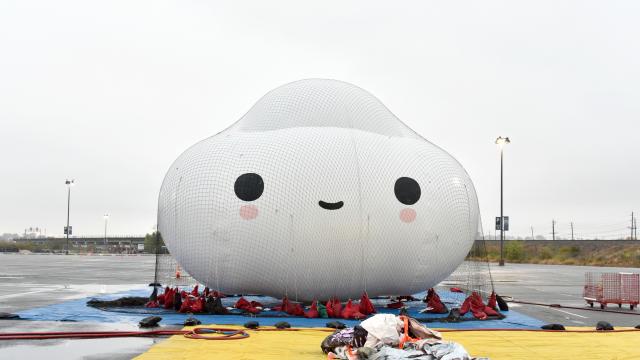If you read the news on Monday, you may have heard people freaking out about how climate change is finally coming for the clouds. A study released in Nature Geoscience chronicles how stratocumulus clouds, those low hanging clouds that lend themselves well to daydreaming, could one day disappear if we keep emitting carbon.
Their disappearance could, in turn lead to skyrocketing temperatures, raising the heat more than 8 degree Celsius around the globe.
Look, that is extremely super bad. If the clouds disappeared, the planet would likely be a scorched, parched hellscape that makes Mad Max look like a selfie-filled weekend at Bonnaroo. This paper is an important addition to the literature on an important topic, one researchers are furiously looking at because clouds play a crucial role in the climate system but are among the least understood components.
Indeed if future generations ever get to the point of watching clouds disappear, they’ll be lucky. The study is based on a scenario where carbon dioxide rises to 1,200 parts per million, a near tripling of where it’s at today. Technically, it’s possible. But the reality is there’s a lot more stuff climate change could do to could spell the end of civilisation before we reach that point. The current suite of global climate policies have the planet on track to warm more than 3 degrees Celsius, and we’ll pass some horrific milestones along the way.
“I think it’s interesting work and worth lots of further study,” Kate Marvel, a cloud modeler with NASA Goddard Institute for Space Studies, said of the new study. “[The] bottom line is: please freak out about 1,200 ppm because of all the bad things that will happen on the way there, not because the clouds will go away.”
Here’s a list of just some of the ways the planetary system we rely on could unravel before cloud cover is no more.
Runaway ice melt and sea level rise
According to the United Nations, roughly 2.4 billion people live within 97km of the coast and more and more folks are headed there. Which is a little problematic considering sea level rise could force them to beat a hasty retreat back inland or suffer the consequences.
The foot of sea level rise humanity is already dealing with has led to deadly and costly storm surge associated with cyclones, and the problems will only get worse.
“Currently it looks like we will be committed to major loss of ice from Antarctica from 2-3°C of warming, a level we hit long before we hit 1,200 ppm,” Bob Kopp, a sea level rise expert from Rutgers, told Earther.
West Antarctica is at risk of runaway melt—in fact, it may already be underway—and sea levels could rise 3.05m as a result. It would take a long time to get that level of rise, though Kopp noted there’s a “not insubstantial risk that we could hit 1.83m or more” in this century. Regardless, once the wheels are in motion, it would be a foregone conclusion and the resulting inland migration as coastal cities become uninhabitable would reshape society.
Oxygen-less oceans
One other note on oceans. The open oceans of the world have lost an astounding 77 billion tons of oxygen over the past 50 years, leading to an increase in the number and area of so-called dead zones. Much of that is tied to climate change because hotter water just doesn’t hold as much oxygen. In an unfortunate twist, ocean creatures will need more oxygen as the planet warms even as that warming reduces the oxygen available to them.
Denise Breitburg, a senior scientist at the Smithsonian Research Center who recently published a big paper earlier this year on the topic, told Earther it’s like the “old American Lung Association motto ‘when you cant breathe, nothing else matters.’” She didn’t want to say that decreasing oxygen was a bigger concern than the cloud study, but noted that “it’s definitely something we need to be concerned about in the near future because we can see huge changes with the warming we’ve already seen.”
So to review: We could have lifeless, hot, rising seas before the clouds leave us. Great.
Heat waves
The clearest impact of climate change is rising temperatures. And deadly heat waves are now being ‘amped’ up or made more likely by climate change. That’s not good. And the hotter things get, the more human lives will be at risk.
The world lost 153 billion hours of work to heat in 2017 alone. Hot weather can also make it harder for kids to learn, and both these factors mean economic output could drop. If that’s not enough, research suggests crime rates are also highest during warmer months and on the hottest days, so perhaps we’ll just all kill each other in a fit of climate change-induced rage.
To top it off, extreme heat stunts the growth of staple crops. If the world warms 2 degrees Celsius (3.6 degrees Fahrenheit), a level that’s deemed somewhat safe under the Paris Agreement, U.S. corn production could drop an alarming 18 per cent. Other countries could also see double digit drops, increasing the risk of food insecurity and the societal ills that come with it.
Geoengineering
Long before we hit 1,200 ppm, it will be hot. Very, very hot. So it’s not out of the question world leaders or a rogue billionaire will try to dim the sun to cool the planet. Some see this scenario as inevitable given that nobody has shown an appetite for reducing carbon emissions. But while geoengineering may cool the globe as a whole, it also could shift rainfall patterns.
Crops may respond negatively to less sun, and ocean acidification will continue unchecked as long as carbon emissions continue.
